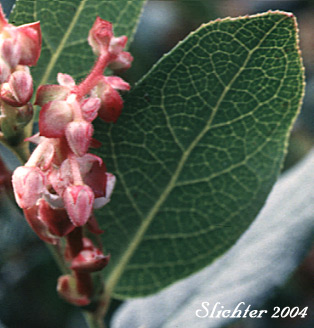 The
photo at right shows the evergreen leaf and cream or pink, bell-shaped flower
of salal. Photographed at Sutton Creek Camp Ground, Oregon coast.........March
1998. Note the netted veins.
The
photo at right shows the evergreen leaf and cream or pink, bell-shaped flower
of salal. Photographed at Sutton Creek Camp Ground, Oregon coast.........March
1998. Note the netted veins.
Salal is an attractive creeping to erect shrub with much branched stems from 50-250 cm long. The stems are covered in part with long, loose to stiff hairs. The thick, leathery leaves are large and ovate to ovate-elliptic in shape. They measure 5-10 cm long and 3-5 cm wide. The upper blade is glabrous and shiny green while the lower blade surface is glandular while the margins are lightly toothed.
The inflorescence consists of a bracteated raceme (Notice large, leafy but purplish floral bracts in the photo at right.) of 5-15 flowers. The racemes are terminal and may also be found from the upper axils. The raceme is about 5-12 cm long and turned to one side. The pedicels and calyx as well as the corolla all are covered with glandular hairs (See photos.). The calyx is up to half as long as the corolla and the calyx lobes are triangular and slightly longer than wide. The urn-shaped corolla is pendant and white or pinkish in color. They measure 6-10 mm long. The fruit is a blackish to purplish, oblong to globose berry covered with a yeast bloom that measures 7-10 mm wide.
Salal is an excellent ground cover and may serve as a hedge in areas near the Pacific coast. The berries are edible and may be eaten raw or cooked.
Salal may be found in open to moderately dark forests as well as in clearcuts and forest clearings from sea level to moderate elevations in the mountains. It attains its largest size near the coast and is much reduced in size further inland.
Salal is commonly found west of the Cascade crest from British Columbia south to southern California. It is also found at several sites in the Blue Mts. of Oregon.
In the Columbia River Gorge, it may be found between the elevations of 100'-3400' from the Sandy River east to near the Little White Salmon River.